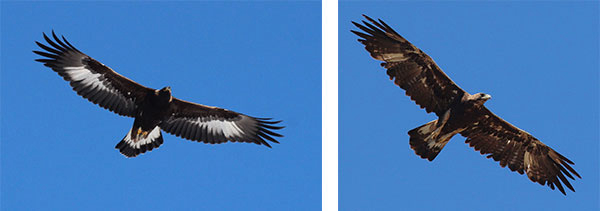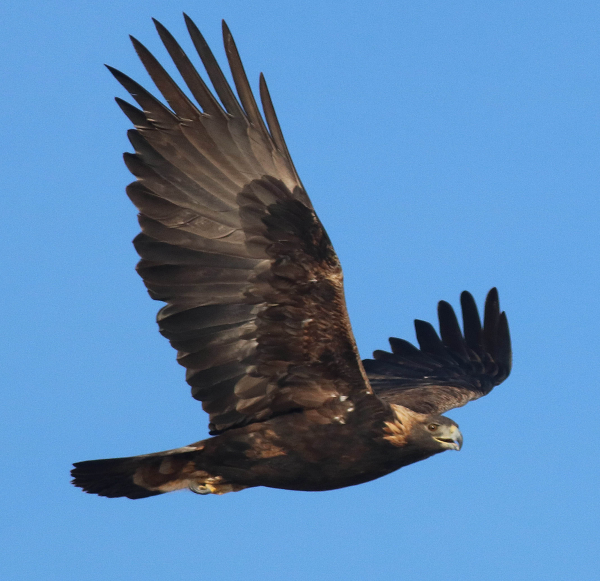Among non-birders, a lot of misinformation is exchanged through word of mouth among people who speak authoritatively about eagles, resulting in local folklore created by folks who have never opened a book or field guide to glean basic information about our two fantastic North American eagles – Bald Eagles and Golden Eagles. Many non-birders are under the impression that only eagles that have a white head and tail are Bald Eagles, but of course, we know that only adult Bald Eagles possess the tell-tale white head and tail traits. It takes four years for a young Bald Eagle to attain adult plumage. Until then, they are often, if not usually, mistakenly identified as Golden Eagles by the uniformed and mis-informed.

Even among our ranks of birders, it can be hard to gain the experience to go along with studying field guides, including focused raptor field guides. We all know that it’s one thing to see a set of illustrations or photos, read the descriptions for each species, and factor that into field observations. Seeing the eagles in the field is most helpful, if not necessary. But why do so few non-birders skip the bookwork? It’s simple, I guess, it’s like trying to tell the difference between different makes and models of cars, it’s a matter of having enough interest to do a little searching, and some literary research.
Realistically, it’s possible to zero in on the differences between sub-adult Bald Eagles and Golden Eagles, subtle as they may be. The first thing is to get a close look, and if not a close look, a good look with binoculars or a spotting scope. Better yet, it’s great to view eagles through a camera with telephoto or zoom lens – and take a photo or series of photographs that give you even more of an opportunity to study the finer plumage differences of these magnificent birds. Using your camera as a tool, a documentary tool, you can help yourself and others to learn the true identity of eagles that lack a white head and tail. Let’s start with Golden Eagles, partly because they a bit less variable and they can be narrowed down to three plumage groups: Adult, first year, and immature plumages.

Golden Eagle Plumages
Adult Golden Eagles have no white on their feathers. They are a fairly uniform brown color, with the exception of the gold feathers that extend from the crown of the head to the nape of the neck. Adult Goldens’ feathers often show some veined coloration, especially on the large tail and secondary wing feathers.
First year Golden Eagles show considerable white on the base half of their tail feathers that creates a broad white band across the base of the tail and a broad brown terminal band. Most first year Goldens also have white wing “patches” in the center of each wing. The amount of white on the wings is variable, and a small percentage of first year Goldens have no white in their wings, although they all show the white band along the base of the tail feathers.
During the period between the first year and adult plumages, immature Golden Eagles show a small amount of white in the wings, and less white in the tail. The rest of immature Golden Eagle plumage is uniformly brown save the ever-more golden nape.

Bald Eagle Plumages
Aside from the very identifiable adult Bald Eagle plumage, which any American or Canadian citizen can accurately identify by their white head and tail, immature Bald Eagles are mostly brown during their first year, and pretty variable during the two years thereafter, before they show some white coloration in their head and tail feathers the year before attaining their white head and tail and brown body plumage.
First year Bald Eagles are mostly a uniform brown color on their dorsal side and body during their first year, but the belly feathers begin to pale by winter, and the underside of the wings show a lot of speckled white coloration.

Second and third year Bald Eagles are widely known as “speckle-bellies,” which accurately describes their primary trait and strongly distinguishes them from any Golden Eagles as well as first year and adult Bald Eagles.

There is no mistaking an adult Bald Eagle, one of the most identifiable birds in America.
|
As noted on the first photo caption in this article, a picture is worth a thousand words, so I tried to select some characteristic photos that are representative of each of each of the plumage groups of each species. If you’re ready to delve into the bookwork, a couple key raptor field guides provide excellent source material: Birds of Prey of the West by Brian Wheeler; and I found the illustrations of John Schmitt’s eagles in William Clark’s book, Raptors of Mexico and Central America to be the best examples of the varied plumages of Golden and Bald Eagles. Bill and Brian’s historic book, A Photographic Guide to North American Raptors, is always a go-to book to use too.
Article and photographs by Paul Konrad
Share your bird photos and birding experiences at editorstbw2@gmail.com